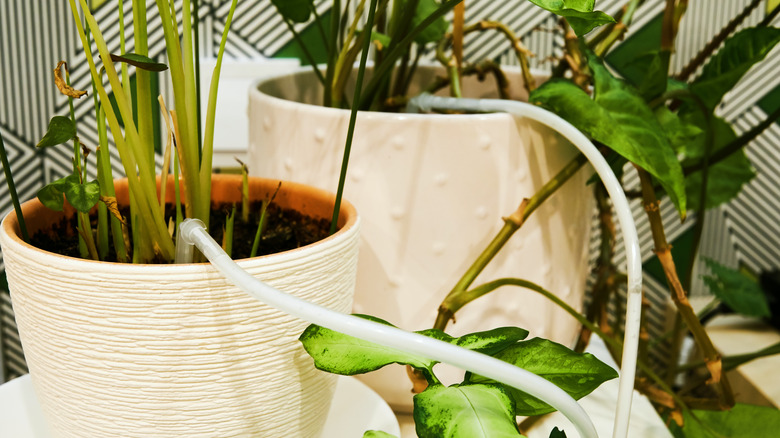Why Showering Your Plants With Nutrients Is Actually A Bad Idea
If you're a beginner gardener or new to collecting houseplants and eager to grow your indoor urban jungle, you may fall prey to a common mistake amongst newbies — over-fertilizing your plants. You may have good intentions, wanting to do all you can to help your plants grow to their full potential faster, but this can actually lead to disaster in the form of nutrient burn. Nutrient burn causes irreversible damage to roots and leaves, which in turn hinders the plant's ability to photosynthesize and actually harms its growth.
The problem with overfeeding your plants is that they don't have processes by which they can store any excess energy obtained from nutrients. If you overfeed a pet they will simply put on weight because they can store the excess nutrients inside fat cells for use later on. But plants are different — they experience nutrient burn instead.
If you oversaturate plants with fertilizer you may start to notice the leaves develop crispy brown patches. These are the burnt areas that have lost the ability to absorb energy from the sun. There are usually warning signs before the plant reaches a critical level — for example, the leaves may turn deep green, curling at the edges, and then you'll notice the tips turn yellow and brown. This is the plant's attempt to get rid of excess nutrients by pushing them to the far ends of the leaves.
How to fix nutrient burn in plants
Plants can definitely recover after getting nutrient burn, but the damaged leaves won't heal. This is why you can't judge the health of a plant that has been affected by nutrient burn from its old leaves. The best way to monitor your plant is to keep an eye on the new growth and make sure the new leaves are growing healthy and green. If the new growth isn't developing burns, then this is a good sign nutrient burn might have subsided.
In order to fix nutrient burn in your plant you need to flush out the excess nutrients by cleaning the roots with pH-balanced water. With houseplants that are potted in soil, ensure that the pots drain properly by ensuring they have sufficient drainage holes and the correct soil mix for the plant. You may have to replant in pots with more perforated holes at the bottom and a potting mix that allows for better water drainage.
To flush out the excess nutrients from overfertilizing, use a hose, directing the water onto the bottom of the stem. From here, it should filter through the soil and out the bottom of the pot. Allow the plant time to recover and for nutrient levels within the plant to decrease before fertilizing again. The next time you fertilize the plant, do so sparingly, using only half the recommended amount at first.
Tips for prevention
If you're worried about fertilizing your plants because you've heard about nutrient burn or you've experienced it with plants before, the best advice you can live by is the advice on the box of fertilizer you're using. Following the instructions will give your plants the best opportunity to get what they need out of a given product and thrive.
When it comes to fertilizer, make sure that the product you choose is suitable for the types of plants you're growing and also the substrate your plants are growing in. This may mean that you have to buy different types of fertilizer for different plants in your home or garden — for example, the perfect flower fertilizer may be different from the best fertilizer for healthy tomatoes. The quality of your soil is also just as important for the health of your plants.
It's easy to make common mistakes when fertilizing your garden. For example, expecting a fertilizer to solve problems that are being caused by other things like poor access to sunlight or over/under-watering. Your plants need to be healthy to begin with before addressing their fertilization needs, and the soil needs to be the ideal environment for fertilizer to feed your plant.


